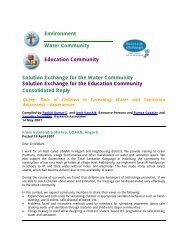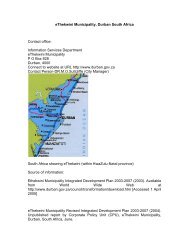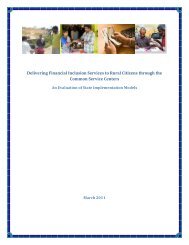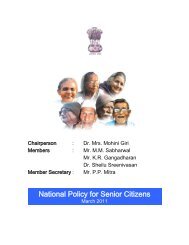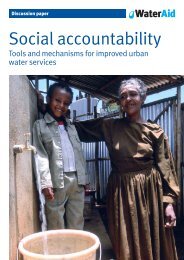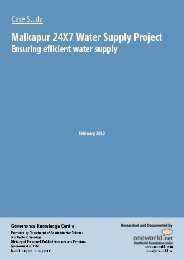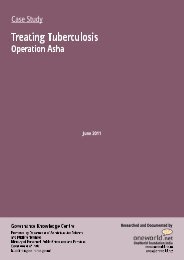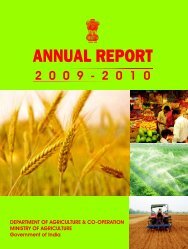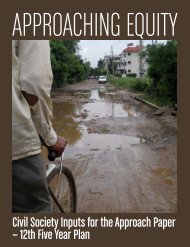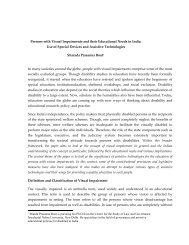EMRI model - Indiagovernance.gov.in
EMRI model - Indiagovernance.gov.in
EMRI model - Indiagovernance.gov.in
Create successful ePaper yourself
Turn your PDF publications into a flip-book with our unique Google optimized e-Paper software.
Study of Emergency Response Service (<strong>EMRI</strong> Scheme)negotiated for each ambulance is improv<strong>in</strong>g. On the other hand the merits of the ris<strong>in</strong>gcosts of build<strong>in</strong>g and the requirements of so much land are not clear. It has been arguedby adm<strong>in</strong>istrators that the space required for a call center operation with someadm<strong>in</strong>istration space would have sufficed. <strong>EMRI</strong>’s position is that some 120,000 sq ft ofbuilt up area is required- for adm<strong>in</strong>istration, call center and tra<strong>in</strong><strong>in</strong>g space. Any additionalarea though desirable for develop<strong>in</strong>g the place with gardens and so on, is not essential.3. The operat<strong>in</strong>g cost per trip is also vary<strong>in</strong>g across states and over the years. Thus for theyear 2008, <strong>in</strong> Andhra Pradesh it is Rs 565, <strong>in</strong> Gujarat it is Rs 635 and <strong>in</strong> Rajasthan it isabout Rs 2700. Rajasthan’s higher costs could be expla<strong>in</strong>ed as higher first year costs,as the Gujarat <strong>EMRI</strong> also had a cost of Rs. 2872 per trip, <strong>in</strong> the first year. It obviouslytakes time for the news to get around, and the demands for services to emerge.However, it is also seen that after a po<strong>in</strong>t ris<strong>in</strong>g demand or <strong>in</strong>creased number ofambulances does not lead to same rate of decl<strong>in</strong>e <strong>in</strong> costs per trip. Thus <strong>in</strong> Gujarat, withan average of 4.31 trips per day and 402 ambulances, it costs Rs. 635 per trip whileAndhra Pradesh with 652 ambulances and 8.1 trips per ambulance, it costs Rs 565 pertrip – for almost the same average distance of 29 to 30 km per trip.4. Cost per ambulance per year, <strong>in</strong> contrast to cost per ambulance per trip, cont<strong>in</strong>ues torise with number of years of utilization and <strong>in</strong>creased frequency of use. There are alsowide variances across states. Thus, it is Rs 6.68 lakhs per year <strong>in</strong> Gujarat at an averageof 4.31 trips, but it rises to Rs 12.59 lakhs per year <strong>in</strong> Andhra Pradesh with double theaverage number of trips per ambulance of 8.1.5. As utilization <strong>in</strong>creases and the more trips each ambulance makes, the higher thesecosts would be. Today Andhra is reach<strong>in</strong>g 8 trips per ambulance per day with oneambulance per 1.23 lakh population at Rs 565 per ambulance trip or Rs 16.5 lakhs perambulance per year and for 652 ambulances the current year’s expenditure is 107crores. If this were to <strong>in</strong>crease to two ambulances per one lakh population, i.e 1600ambulances for the state and 11 trips per day per ambulance and also assume thataverage cost per trip were to stabilise at a lower Rs 475 per trip (estimate on optimumefficiency) then the costs would plateau at about Rs 305 crores at current rates andwithout adjust<strong>in</strong>g for the <strong>in</strong>creased costs of low population density <strong>in</strong> high dispersionareas. Thus <strong>in</strong> Andhra Pradesh, <strong>in</strong> the third year of operation, when 30% of allemergencies are estimated as be<strong>in</strong>g picked up by the ERS, the expenditure on ERS iscurrently about Rs 13.4 crores spent per crore of population per year. This could riseand f<strong>in</strong>ally plateau at about Rs 38 crores expenditure per crore of population per year forthe provision of universal ERS. (One could use these two sets of figures for cast<strong>in</strong>g all-India estimates as well as projections for each state).6. In Rajasthan however the per ambulance per year costs are very high (Rs 12 crores),even at very low utilisation, because the salary costs and the adm<strong>in</strong>istrative costs makeup the major part of the costs. Even <strong>in</strong> Gujarat, the first year of use had the samepattern.National Health Systems Resource Centre (NHSRC)26



